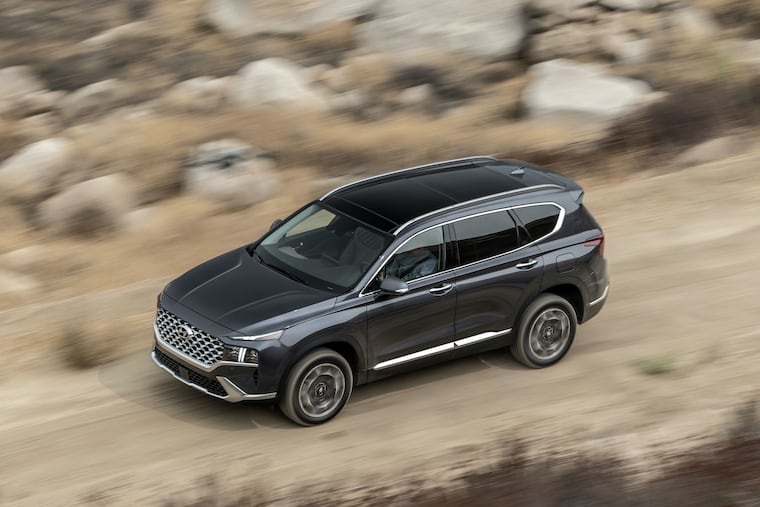New Hyundai Santa Fe offers excellent seating and storage, but lacks on fuel economy
Hyundai wants to call the midsize SUV “adventurous,” but it seems more “agreeable."

2023 Volkswagen Atlas Cross Sport vs. Hyundai Santa Fe vs. Toyota 4Runner: Three approaches for roomy SUVs.
This week: Hyundai Santa Fe Calligraphy AWD
Price: $45,255. Floor mats added $210 to the price.
Conventional wisdom: Car and Driver likes the “affordable pricing, lower trims offer desirable equipment, comfy ride,” but not that the “base engine is a slouch, some rivals achieve better fuel economy, rear seating could offer more headroom.”
Marketer’s pitch: “The adventurous family SUV.”
Reality: Adventurous is a little strong. Perhaps amiable?
What’s new: The midsize SUV from Hyundai gets some exterior and interior updates for the model year; its last redesign came in 2019, which Mr. Driver’s Seat tested and can compare with. But its beauty lies in its mostly cooperative handling and livability.
» READ MORE: From 2018: Battle of the econoboxes: 2019 Hyundai Accent deletes hatchback from the redesign | Scott Sturgis
The Santa Fe has regular and turbo engine options, plus hybrid and plug-in versions as well.
Competition: Honda Passport, Volkswagen Atlas Cross Sport, Toyota 4Runner.
Up to speed: The 2.5-liter turbo four-cylinder engine produced fine power, 281 horses in the upscale version tested. It trotted to 60 mph in 6 seconds, according to Car and Driver.
But power delivery can be random. In Snow mode, I found the engine to suffer from turbo lag akin to 1990s models, a downfall mostly eliminated from today’s vehicles.
In Sport mode, the problem was less severe, but the vehicle often overreacted to the lightest tap on the gas pedal, particularly when passing or adding some power on the highway. Smart mode made that overall acceleration much smoother, but with its own downfall (see “On the road,” below).
A test of a 2019 model revealed similar problems despite completely different engines. I’d say watch out for this in Hyundais in general.
Lesser Santa Fes get a 191-horsepower version of the 2.5, while hybrids and plug-in hybrids get a 1.6-liter four coupled with an electric motor.
Shifty: The 8-speed automatic transmission operates without bother, a big improvement over the 2019, which suffered from abrupt shifts. The dual-clutch system seems to be getting refined after a problematic intro four or five years ago across Hyundai and Kia lineups.
Operation is simple as well: Twist to the left for Reverse, to the right for Drive, and press the button for Park.
On the road: The Santa Fe offers ho-hum handling, even in Sport mode. Curves are handled without much excitement. This point rated better in the 2019 model, though.
On a long trip up north on a bitter cold winter day, I ran it in Snow mode in case of surprise ice patches, and the handling did just fine, but again, nothing to write home about.
Sport mode does improve handling, but I can’t give it a full thumbs up. Smart mode makes the steering far looser. Nice for regular driving, but definitely not for zigging or zagging.
Driver’s Seat: One giant improvement comes in seating. I previously complained of seats that mimicked a punch to the kidneys; this time around, that long trip left me only a little squirmy.
But the steering telescope and tilt left me feeling like a T-Rex: “I have a large head and tiny arms! I don’t think you thought this through very well!”
Controls follow Hyundai’s usual offerings and are fairly clear and simple.
Friends and stuff: The rear seat provides plenty of space to stretch out, according to Sturgis Kid 4.0, and the seat itself is comfortable.
Cubbies abound in the Santa Fe, with a tray above the glove box that actually holds things in place, a nice phone slot on the console, and large-bag storage underneath the console.
Cargo space is 36.4 cubic feet in back, 72.1 with the second row folded.
Play some tunes: Dials for volume and tuning sit atop the console near the touchscreen, and a row of buttons between them accesses all the major functions. The attractive upright 10.25-inch touchscreen could be a little uncooperative, but I did have the Santa Fe during some major cold weather and my fingers could have been excessively dry. (Ask me how much fun putting in and taking out my contact lenses were this very same week. And next week’s Driver’s Seat, we test skin moisturizers.)
Still, it does point to some of the limitations of our major automotive advances, like touchscreens and driving-aid systems — simple things like the weather can send them into a tizzy.
Sound from the system is pretty good, somehow clearing up a few songs nicely but not others. I’ll call it an A-.
Keeping warm and cool: The Lovely Mrs. Passenger Seat raved about the seat heaters. The Santa Fe definitely turns up the heat, an important feature when temps are in the single digits outside.
HVAC features operate fairly well. The trade-off for the under-console storage is a console that features all the HVAC and radio controls. Despite being clear and following typical patterns, they’re surprisingly challenging to see while driving and require a head turn every time. Maybe this clears up over time, or maybe it’s just me.
Fuel economy: I averaged about 22 mpg in a highway-heavy round of driving, and this was only slightly less than where the vehicle had been averaging before me. I guess spring for a hybrid.
Where it’s built: Montgomery, Ala.
How it’s built: Consumer Reports predicts a Santa Fe reliability rating of 3 out of 5.
Next week: Toyota 4Runner 40th Anniversary